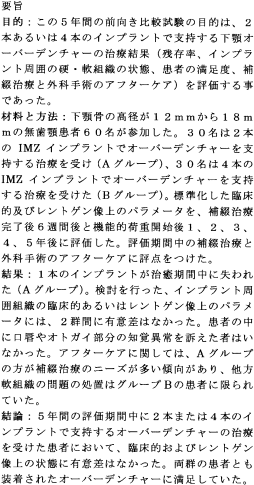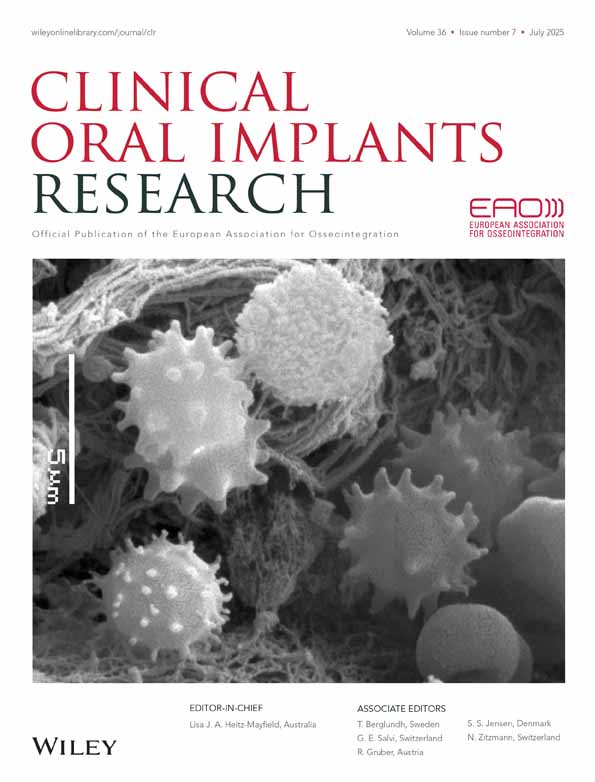Mandibular overdentures supported by two or four endosseous implants
Hybridprothesen im Unterkiefer getragen von 2 oder 4 enossalen Implantaten
A 5-year prospective study
Abstract
enObjective: The aim of this 5-year prospective comparative study was to evaluate treatment outcome (survival rate, condition of hard and soft peri-implant tissues, patient satisfaction, prosthetic and surgical aftercare) of mandibular overdentures supported by two or four implants.
Material and methods: Sixty edentulous patients with a mandibular height between 12 and 18 mm participated. Thirty patients were treated with an overdenture supported by two IMZ implants (group A) and 30 patients were treated with an overdenture supported by four IMZ implants (group B). Standardised clinical and radiographic parameters were evaluated 6 weeks after completion of the prosthetic treatment and after 1, 2, 3, 4 and 5 years of functional loading. Prosthetic and surgical aftercare was scored during the evaluation period.
Results: One implant was lost (group A) during the healing period. There were no significant differences with regard to any of the studied clinical or radiographic parameters of the peri-implant tissues between the groups. None of the patients reported sensory disturbances in the lip or chin region. No differences in satisfaction were observed between the groups. With regard to aftercare, there was a tendency of a greater need of prosthetic interventions in group A, while correction of soft-tissue problems was restricted to patients of group B.
Conclusion: There is no difference in clinical and radiographical state of patients treated with an overdenture on two or four implants during a 5-year evaluation period. Patients of both groups were as satisfied with their overdentures.
Résumé
frLe but de cette étude comparative et prospective de cinq années a été d'évaluer la guérison (taux de survie, condition des tissus paroïmplantaires mous et durs, satisfaction du patient, prothèse et chirurgie) de prothèses mandibulaires sur deux ou quatre implants. Soixante édentés avec une hauteur mandibulaire entre douze et 18 mm ont participé. Trente patients ont été traités avec une prothèse ancrées sur deux implants IMZ (groupe A) tandis que les trente autres ont été traités avec une prothèse ancrée sur quatre implants IMZ (groupe B). Les paramètres radiographiques et cliniques standards ont étéévalués six semaines après la mise en place de la prothèse et ensuite une, deux, trois, quatre et cinq années après la mise en charge fonctionnelle. Le suivi chirurgical et prothétique a étéévalué durant cette période. Un implant a été perdu dans le groupe A durant la période de guérison. Il n'y avait aucune différence significative en ce qui concerne aucun des paramètres radiographiques et cliniques étudiés des tissus paroïmplantaires entre les deux groupes. Aucun des patients n'a rapporté d'ennuis sensoriels au niveau de la lèvre ou du menton. Aucune différence dans la satisfaction n'a été observée entre les deux groupes. En ce qui concerne le maintien, une nécessité plus importante d'intervention au niveau des prothèses était constatée dans le groupe A tandis que la correction des problèmes des tissus mous n'a dûêtre effectuée que chez les patients du groupe B. Il n'y a donc aucune différence radiographique ou clinique chez les patients traités avec une prothèse ancrée sur deux ou quatre implants durant un suivi de cinq années. Les patients des deux groupes étaient autant satisfaits de leurs prothèses.
Zusammenfassung
deZiel: Das Ziel dieser prospektiven vergleichenden Studie über 5 Jahre war, das Behandlungsresultat (Ueberlebensrate, Zustand der peri-implantären Hart- und Weichgewebe, Patientenzufriedenheit, prothetische und chirurgische Nachsorge) von Hybridprothesen im Unterkiefer, welche von 2 oder 4 Implantaten getragen werden, zu untersuchen.
Material und Methoden: An der Studie nahmen 60 zahnlose Patienten mit einer Unterkieferhöhe zwischen 12 und 18 mm teil. 30 Patienten wurden mit einer Hybridprothese getragen von 2 IMZ Implantaten versorgt (Gruppe A), und 30 Patienten erhielten eine Hybridprothese auf 4 IMZ Implantaten (Gruppe B). Standardisierte klinische und radiologische Parameter wurden 6 Wochen nach Eingliederung der Rekonstruktion und nach 1,2,3,4 und 5 Jahren funktioneller Belastung ausgewertet. Die prothetische und chirurgische Nachsorge wurde während der Beobachtungsperiode aufgezeichnet.
Resultate: 1 Implantat ging während der Einheilphase verloren (Gruppe A). Es bestanden keine signifikanten Unterschiede in Bezug auf die untersuchten klinischen und radiologischen Parameter der peri-implantären Gewebe zwischen den zwei Gruppen. Keiner der Patienten beklagte Gefühlsstörungen im Bereich der Lippe oder des Kinns. Zwischen den zwei Gruppen bestanden keine Unterschiede bezüglich Zufriedenheit. Bei der Nachsorge bestand eine Tendenz eines grösseren Bedarfs an prothetischen Interventionen in Gruppe A, während Korrekturen von Weichteilproblemen auf Patienten der Gruppe B beschränkt waren.
Schlussfolgerung: Es bestehen keine Unterschiede in den klinischen und radiologischen Befunden bei Patienten, welche für eine Beobachtungsperiode von 5 Jahren mit Hybridprothesen auf 2 oder 4 Implantaten versorgt worden waren. Die Patienten beider Gruppen waren mit ihren Hybridprothesen zufrieden.
Resumen
esObjetivo: La intención de este estudio fue prospectivo comparativo de 5-años fue evaluar los resultados del tratamiento (índice de supervivencia, condiciones de los tejidos duros y blandos periimplantarios, satisfacción del paciente, mantenimiento postquirúrgico y postprotesico) de sobredentaduras mandibulares soportadas por 2 o 4 implantes.
Material y Métodos: Participaron 60 pacientes edéntulos con una altura mandibular entre 12 y 18 mm. Se trataron 30 pacientes con una sobredentadura soportada por 2 implantes IMZ (grupo A) y 30 pacientes se trataron con una sobredentadura soportada por 4 implantes IMZ (grupo B). Se evaluaron parámetros clínicos y radiológicos a las 6 semanas tras conclusión del tratamiento protésico y tras 1, 2, 3, 4 y 5 años de carga funcional. Se tomó nota del mantenimiento prostético y quirúrgico durante el periodo de evaluación.
Resultados: Se perdió un implante (grupo A) durante el periodo de cicatrización. No hubo diferencias significativas respecto a ninguno de los parámetros clínicos y radiográficos estudiados de los tejidos periimplantarios entre los grupos. Ninguno de los pacientes informó sobre molestias sensoriales en el labio o la región del mentón. No se observaron diferencias entre los grupos respecto a la satisfacción. Respecto al mantenimiento, hubo una tendencia a una mayor necesidad de intervenciones prostéticas en el grupo A, mientras que las correcciones en los tejidos blandos se circunscribieron al grupo B.
Conclusiones: No hay diferencias en el estado clínico y radiográfico de los pacientes tratados con una sobredentadura en 2 o 4 implantes durante un periodo de evaluación de 5 años. Los pacientes de ambos grupos estaban satisfechos con sus sobredentaduras.





